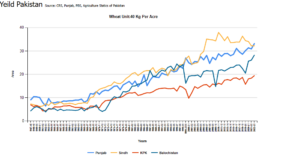Introduction
Wheat is Pakistan’s staple food crop, playing a crucial role in ensuring food security and supporting the agricultural economy. Pakistan is among the world’s leading wheat-producing countries, with Punjab contributing the largest share, followed by Sindh, Khyber Pakhtunkhwa (KPK), and Balochistan.
This article explores the importance of wheat, historical production trends, and a comparative study of area, production, and yield across provinces from 2010-11 to 2022-23.
Importance of Wheat in Pakistan
1. Nutritional Value
Wheat is a primary source of carbohydrates, providing energy to millions.
It is rich in proteins, fiber, vitamins (B-complex), and minerals (iron, zinc, and magnesium).
It forms the basis of staple foods like roti, chapati, and bread in Pakistan.
2. Economic Significance
Wheat contributes over 10% to the value-added agriculture sector.
It supports millions of farmers and plays a vital role in the rural economy.
The wheat supply chain involves flour mills, storage, processing, and export industries.
3. Food Security
Wheat ensures food self-sufficiency and reduces reliance on imports.
Government policies focus on wheat procurement, subsidies, and buffer stocks to stabilize prices.
Comparative Analysis of Wheat Production in Pakistan (2010-11 to 2022-23)
The following sections analyze wheat area, production, and yield trends in Punjab, Sindh, KPK, and Balochistan, highlighting regional disparities.
1. Area Under Wheat Cultivation (Million Acres)
| Year | Punjab | Sindh | KPK | Balochistan | Pakistan |
| 2010-11 | 19.04 | 4.29 | 1.16 | 0.73 | 25.21 |
| 2015-16 | 19.53 | 3.83 | 1.4 | 0.87 | 25.63 |
| 2020-21 | 20.9 | 4.04 | 1.36 | 1.16 | 27.46 |
| 2022-23 | 21.22 | 3.94 | 1.49 | 1.52 | 28.18 |

Observations
Punjab consistently has the largest wheat area, contributing around 75% of the total.
Sindh’s wheat area is declining, dropping from 4.29 million acres in 2010-11 to 3.94 million acres in 2022-23.
Balochistan shows gradual growth, reflecting increased wheat cultivation.
2. Wheat Production (Million Tonnes)
| Year | Punjab | Sindh | KPK | Balochistan | Pakistan Total |
| 2010-11 | 19.04 | 4.29 | 1.16 | 0.73 | 25.21 |
| 2015-16 | 19.53 | 3.83 | 1.4 | 0.87 | 25.63 |
| 2020-21 | 20.9 | 4.04 | 1.36 | 1.16 | 27.46 |
| 2022-23 | 21.22 | 3.94 | 1.49 | 1.52 | 28.18 |

Observations
Punjab remains the dominant producer, with an increasing trend from 19.04 million tonnes in 2010-11 to 21.22 million tonnes in 2022-23.
Sindh’s production fluctuated, influenced by climate variability and water shortages.
Balochistan and KPK saw moderate growth due to the adoption of improved farming techniques.
3. Wheat Yield (40 Kg Per Acre)
| Year | Punjab | Sindh | KPK | Balochistan | Pakistan Average |
| 2010-11 | 28.79 | 37.91 | 16.14 | 21.64 | 104.48 |
| 2015-16 | 28.57 | 33.6 | 18.35 | 23.02 | 103.54 |
| 2020-21 | 31.34 | 34.02 | 18.08 | 25.61 | 109.05 |
| 2022-23 | 33.14 | 32.19 | 19.43 | 28.21 | 112.97 |
Observations
Punjab shows steady improvement, reaching 33.14 (40 kg/acre) in 2022-23.
Sindh’s yield fluctuated due to water shortages and soil salinity.
Balochistan’s yield has significantly improved, suggesting the success of better irrigation and seed varieties.
Challenges Affecting Wheat Production in Pakistan
Despite being a wheat-surplus country, Pakistan faces production and distribution challenges, including:
1. Climate Change & Water Scarcity
Erratic rainfall, heat stress, and droughts affect crop growth.
Glacier melt and irrigation mismanagement impact water availability.
2. Post-Harvest Losses
Inadequate storage facilities and outdated processing techniques lead to 10-15% post-harvest losses.
Poor logistics reduce wheat availability in urban and remote areas.
3. Soil Fertility & Land Degradation
Excessive use of chemical fertilizers depletes soil health.
Salinity issues in Sindh reduce wheat productivity.
4. Policy & Market Issues
Unstable wheat procurement prices affect farmers’ income.
Black marketing and hoarding create artificial shortages.
Future Recommendations for Wheat Sustainability
To enhance wheat production and ensure food security, the following strategies should be adopted:
1. Climate-Resilient Wheat Varieties
Invest in drought-resistant and heat-tolerant wheat seeds.
2. Efficient Water Management
Introduce drip and sprinkler irrigation to conserve water.
3. Improved Storage & Supply Chain
Build modern silos and warehouses to reduce losses.
4. Smart Policy Interventions
Implement fair wheat pricing and subsidies for small farmers.
Conclusion
Wheat remains Pakistan’s most vital food crop, with Punjab leading in area, production, and yield. Sindh, KPK, and Balochistan have shown fluctuations in production trends. Climate change, water scarcity, and policy gaps pose challenges, but with technological advancements, sustainable farming practices, and policy reforms, Pakistan can ensure long-term wheat security.
Download Production of wheat 2024
Download area production and productivity of wheat
The Importance and Trends of Banana Production in Pakistan

